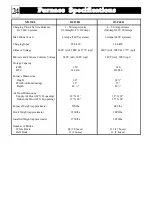
18"
49 1/2"
30"
55 1/2"
69 3/4"
DLF40B
21"
51 1/2"
TOP VIEW
24 1/2"
3 3/4"
SLOT FOR
16" X 25" FILTER
RETURN AIR DUCT IS 24 1/2" X 15"
60"
Installing The Furnace
9
1
SHIPPING
The furnace is shipped disassembled for ease in handling and moving into location where it is to be installed.
(Refer to Table 2 for information on the items shipped with each furnace.)
Table 2
MODEL
BRICK
ELEMENTS
DUCTING
(See Note 1)
(See Note 2)
(See Note 3)
DLF30B
28 boxes Whole Brick (3/Box)
9
1 Box Return Air Filter Rack
2 boxes Half Brick (6/Box)
1 Box Supply Air Blower Plenum Assembly
1 Hardware Package (See Note 4)
DLF40B
37 boxes Whole Brick (3/Box)
12
1 Outdoor Temperature Sensor (See Note 5)
2 boxes Half Brick (6/Box)
NOTES: 1. The furnace ships in two sections (brick storage cavity and base assembly) banded
to one pallet.
2. Each brick box weighs approximately 72 lbs each.
3. The elements are shipped inside the brick storage cabinet of the furnace.
4. The hardware package is shipped in the base assembly portion of the furnace.
5. The outdoor temperature sensor is shipped in the supply air blower plenum assem
bly box.
PLACEMENT
The physical dimensions of the furnace along with the clearances required must be taken into consideration
when choosing a location for the furnace. The minimum area needed for the installation of a furnace is 100
square feet. The best installation location for the furnace is in an area it will be heating. Although most of the
heating requirements of the space will be satisfied by the heat delivered through the duct system, a small amount
of the heating requirements will also be satisfied through static heat dissipating through the furnace's warm
outside panels. In situations where the furnace will not be installed in the area it is intended to heat (i.e. garage),
it is important to account for the heat lost through its panels by making proper adjustments in sizing of the
furnace.
In addition to the physical space requirements, the weight of the furnace must also be taken into consideration
when selecting the installation surface. A level concrete floor is the best surface on which to place the furnace,
but most well supported surfaces are acceptable. If in doubt about floor load capacity, consult a building con
tractor or architect. (See Figure 2 for furnace and ducting dimensions.)
2
FIGURE 2











































